The passenger pigeon once darkened the skies of North America with flocks so vast, they stretched as far as the eye could see.
Imagine looking up and seeing not a patch of blue sky, but rather a living, moving tapestry, woven from the wings of billions of birds.
The passenger pigeon wasn’t just common; it was the continent’s most abundant bird.
Its population numbered in the billions, and people thought it was impossible for such a prolific species to ever disappear.

But then the unthinkable happened. Just like the last piece of a puzzle slipping out of view, the passenger pigeon began to fade away.
The reasons behind their extinction are both simple and sobering.
Despite the bird’s once colossal numbers, relentless hunting and habitat destruction by humans led to their swift and tragic decline.
By the early 20th century, the once mighty flocks were no more.
Can you picture being the last of your kind? The final passenger pigeon, named Martha, must have felt incredibly alone.
In 1914, she took her last breath at the Cincinnati Zoo, marking the grim end of her species.
The disappearance of the passenger pigeon stands as a poignant reminder of the impact humans can have on the natural world.
It’s a story that urges us to take notice and protect today’s wildlife before they too become just a memory.
The Rise and Fall of Passenger Pigeons
Once, skies were darkened by the wings of billions of passenger pigeons, yet within a mere century, this spectacle turned into silence.
This rapid transition from abundance to extinction is one of the most dramatic episodes in natural history.
From Billions to None
In the 19th century, passenger pigeons were perhaps the most populous bird in North America and likely the world.
Estimates put their numbers between 3 and 5 billion.
They moved in enormous flocks that could stretch for miles and take hours to pass a single point—such was the density that they could blot out the sun.
But these impressive numbers belied a fragile existence. By the early 20th century, the species had vanished.
The last confirmed wild bird was shot in 1901, and the final captive pigeon, named Martha, died in 1914.
The Life and Habitat of Ectopistes Migratorius
These birds lived in a complex ecosystem where they played a significant role.
Flocks thrived in deciduous forests of the eastern United States, where they nested and sought foods like acorns, chestnuts, and fruits.
Highly gregarious, passenger pigeons were always on the move to find new resources, enabling trees to disperse their seeds far and wide.
They were a sight to behold: sleek birds with reddish bodies and blue-gray heads, who loved to roost and breed in large communities.
The Role of Human Influence
Human influence dramatically accelerated the disappearance of the passenger pigeon.
With the arrival of European settlers, two main factors contributed to the species’ decline: unregulated hunting and habitat destruction.
Their meat was cheap and their population seemed endless—a problematic combination that led to rampant overhunting.
Simultaneously, vast tracts of forests, the natural habitat of these pigeons, were cleared for agriculture and urban development.
The ecosystem they relied on was disintegrating.
The pigeons could not adapt quickly enough to these rapidly changing conditions, leading to their demise.
Remember how massive these flocks once were?
Imagine how their disappearance not only silenced a species but also changed an entire ecosystem that had thrived with the passenger pigeon at its heart.
How do you think our skies and forests have changed without these winged wonders?
The Iconic Martha and Beyond
Martha, the last of the passenger pigeons, serves as a poignant symbol of what can happen when humans don’t take care of the natural world.
She lived out her final days at the Cincinnati Zoo and her passing left a lasting impact on conservation efforts worldwide.

Martha’s Legacy
In the quiet confines of the Cincinnati Zoo, a bird named Martha marked the end of an era.
She wasn’t just any bird but the very last passenger pigeon.
Her species, which once soared in numerous flocks across North American skies, succumbed to extinction in 1914.
Her demise awakened the world to the consequences of overhunting and habitat destruction.
Can you imagine what it was like when skies grew silent of pigeon wings?
Conservation Messages
Martha’s story isn’t just a tale of loss; it’s a powerful call to conserve what we have before it’s too late.
Her life and death energized movements aimed at protecting other vulnerable species.
Museums preserve not just Martha’s body but the urgent conservation lessons her species spared.
Have you ever found yourself wondering what animals we could be saving right now?
Memories Preserved in Museums
Beyond the threshold of the Cincinnati Zoo, Martha’s remains now reside at the Smithsonian Institution, ensuring her story isn’t lost to time.
Curious eyes can gaze upon her and reflect on humanity’s impact on the natural world.
Museums around the globe use her narrative to embrace a future where wildlife is honored and sustained, inviting each visitor to ponder how they can contribute to that future.
Isn’t it amazing how much we can learn from a single bird’s life?
Science and the Passenger Pigeon

Exploring the past through science provides a window into the mysteries surrounding the passenger pigeon’s disappearance.
Through genetic analysis, scientists seek to understand the evolutionary history and potential future for this extinct species.
Genetic Insights into Extinction
Researchers have uncovered that the passenger pigeon’s genetic diversity was surprisingly low for such a numerous species.
This low genetic diversity may have made it difficult for the bird to adapt to changing environmental conditions and human pressures.
The passenger pigeon’s massive population size—a hallmark of the species—was reflected in their DNA, which showed evidence of natural selection shaping their genetic makeup.
These birds had a unique genetic structure, tailored to support their vast numbers and highly social lifestyle that unfortunately may have contributed to their vulnerability.
Future Hopes: De-extinction
The idea of bringing the passenger pigeon back from extinction isn’t just a dream.
It’s grounded in the emerging field of de-extinction science which uses DNA from preserved specimens to potentially resurrect lost species.
By sequencing the genome of the passenger pigeon, scientists gain valuable insights into its biology and genetics.
These details provide a foundational understanding necessary for de-extinction efforts, raising hopes that one day, science might reverse the fate of these birds.
Can you imagine a sky once again filled with the silhouettes of passenger pigeons?
Through careful study and advanced technologies, the boundary between history and the present gets a little blurry, giving the passenger pigeon a flutter of a future possibility.
Reflecting on Past Lessons

The tale of the Passenger Pigeon is not just a story; it’s a powerful history lesson on the impact of human actions on nature.
From the flocks that once filled the skies to their untimely demise, the journey of these birds serves as a crucial learning moment for conservation today.
Connecting History with Today
Once upon a time, Passenger Pigeons were as common as the air we breathe. Their numbers were so immense that they could darken the skies.
Imagine looking up and seeing a sea of feathers where the blue used to be!
That was the astonishing reality during the time of early European settlers in North America.
However, without knowing it, these settlers were setting the stage for one of the most tragic disappearances in history.
As trees fell to clear land for towns and farms, the vast forests that were home to the pigeons became a memory.
The deforestation not only removed their habitat but also disrupted ecosystems and the balance of life within them.
Can you picture being able to whisper goodbye to an entire species? That’s exactly what happened with the Passenger Pigeon.
With the rise of human communities came the birth of the commercial pigeon industry.
Hunting for sport and the craved pigeon meat in markets became rampant, demonstrating how human activities can sometimes harm the very beauty they admire.
Oddly enough, it never crossed the minds of people back then that an animal as plentiful as the Passenger Pigeon could ever vanish, but it did.
And just like that, nature’s lesson was etched in time — abundance can be fleeting when faced with human demand.
The Imperative for Conservation
Fast-forward to today, and here we are learning from those feathered friends of our past.
The disappearance of the Passenger Pigeon sends a clear message: every creature plays a role in our big, interconnected world.
This is why conservation efforts are so critical.
Scientists and conservationists strive to protect what’s left and restore what’s been lost, giving a second chance to other species teetering on the edge of their very existence.
Did you know we can protect something as small as a bee and yet have a big impact on our environment? That’s right!
By saving one species, we can help many others, including ourselves.
Nations worldwide have come together to create laws and reserves to shield nature from the same fate as the Passenger Pigeon.
It’s like a safety net around the world’s most precious living treasures.
The loss of the Passenger Pigeon did not go in vain; instead, it serves as a constant reminder that humanity holds the power to preserve the planet’s biodiversity.
Let’s take this history lesson to heart and strive to be guardians of the wildlife sharing our home — Earth.
Frequently Asked Questions

Discover the answers to some common curiosities surrounding the mysterious extinction of the passenger pigeon.
Through these questions, we’ll uncover the story behind this bird’s disappearance.
How did changes in the environment contribute to the passenger pigeon’s extinction?
The passenger pigeon once thrived in North America’s vast forests.
However, widespread deforestation for agriculture and urban development destroyed the bird’s natural habitat.
They depended on large, dense forests to provide food and breeding grounds, and as these forests diminished, so did the pigeons’ ability to survive.
What efforts were made to save the passenger pigeon before it disappeared?
In the late 19th century, when the decline of passenger pigeons was becoming evident, there were efforts to prevent hunting and protect remaining flocks.
However, these measures were too little, too late.
Conservation awareness was not as widespread as it is today, and legal enforcement to protect the species was insufficient.
How did the behavior of passenger pigeons make them vulnerable to extinction?
Passenger pigeons were social birds, nesting and traveling in massive groups.
This trait made them particularly susceptible to large-scale hunting, as hunters could kill many birds with minimal effort.
Their migratory patterns also exposed them to different regions where hunting pressure varied.
What impact did the extinction of the passenger pigeon have on ecosystems?
The extinction of the passenger pigeon had significant effects on ecosystem dynamics.
They played a crucial role in seed dispersal and forest regeneration.
Their absence disrupted these natural processes, leading to changes in forest composition and the distribution of various plant species.
Are there any existing species that are relatives of the passenger pigeon?
Yes, the passenger pigeon has close relatives that are still alive today. One example is the mourning dove, a common sight in North America.
They share some similarities in appearance and behavior, but the mourning dove is far more adaptable, which has helped it survive in a changing environment.
What can we learn from the passenger pigeon’s extinction to protect other species?
The passenger pigeon’s extinction teaches a harsh lesson about the impact of human activities on wildlife.
It reminds us of the importance of early conservation efforts, habitat preservation, and the need to balance human development with nature.
By learning from the past, we can help safeguard the future of other species.









